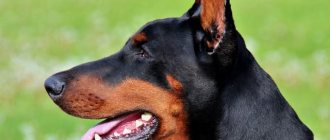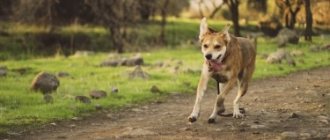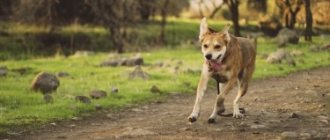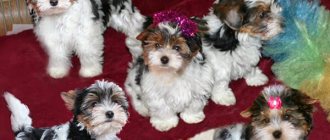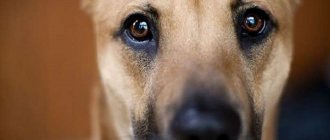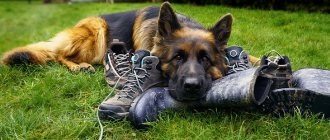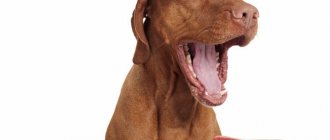Interesting! The very first dogs appeared about 12 thousand years ago, and they were domesticated wolves.
Origin: wolves are descendants of dogs
Scientists are still arguing about who the dog's ancestor was. Two theories emerged from this debate:
- Monophyletic, which states that the ancestor of dogs is a single species.
- Polyphyletic, which holds the view that dogs evolved from different ancestors.
Advances in genetics now suggest that dogs are descendants of a single wolf-like ancestor. As a result of divergence of characteristics due to changes in living conditions, this species of “proto-dog” was divided into two branches: dogs and modern wolves. What significant facts are cited by scientists in favor of this theory:
- the number of chromosomes in both dogs and wolves is 78, while jackals have a different set of chromosomes;
- It is assumed that the habitat of the extinct ancestors of dogs and wolves were territories in Europe, northern Africa, Asia, and North America, which explains the most ancient finds of dog remains in these regions. They were introduced to other parts of the planet later.
The supposed ancestors of dogs are wolves and jackals. This is exactly the hypothesis that was put forward by Konrad Lorenz, an Austrian ethologist who, after many years of observing dogs, wolves and jackals, noted the similarity of behavior and habits.
Archaeologists find the remains of dogs in human settlements, and such finds date back to the Stone Age. The ancestors of dogs lived next door to people, ate their waste, which made it possible to train and domesticate them.
It is noteworthy that the remains were found not in one place, but in different parts of the Earth: in the territory of modern Denmark, England, Sweden, Belgium, Egypt, Iran and the US state of Idaho. And they all date back to approximately the Stone Age, when people were not yet engaged in cattle breeding and agriculture, but obtained their own food by hunting wild animals. The need for certain qualities in dogs has arisen due to changes in people's lifestyles. When they switched to a settled life and began to engage in agriculture and cattle breeding, dogs were required to be able to hunt, protect homes, transport heavy loads, and for military purposes. This is what prompted man to purposeful work on breeding breeds.
Interesting! In the classification of wild animals there is no concept of “breed”. There are about 400 breeds in the modern world. Among them there are breeds, the number of individuals in which is huge and distributed throughout the world, for example, the German shepherd. And some breeds are known only in the country where they were bred and are very narrowly distributed, for example, Norbettenhud in Norway.
Groups of dog breeds: division according to genetic and functional properties
The most recognized classification is the FCI - International Canine Federation, according to which there are 10 groups of breeds, including shepherds, pinschers, schnauzers, terriers, hounds, spaniels and others.
No less common is the classification according to the intended use of breeds. According to it, hunting and non-hunting groups are distinguished.
- Hunting breeds are dogs whose main purpose is to help a person during a hunt. This group includes pointers, retrievers, hounds, dachshunds, terriers, greyhounds, and spaniels. The birthplace of most breeds of hunting dogs is England.
- Non-hunting dog breeds are a diverse group that includes decorative dogs, fighting dogs, sled dogs, herding dogs, Molossians and bulldogs.
How did the breeds originate?
All representatives of the breeds arose from a wolf-like animal 12,000-15,000 years ago, they
are relatives of wolves, jackals, koyts and belong together with them to the canine family. Their similarity is evidenced by the fact that dogs can interbreed with representatives of the species of wolves or jackals and bear offspring.
The dog is the first animal domesticated by man. Why it became possible to habituate the “ancient wolf”, scientists are still arguing. It is assumed that the animals were attracted by the opportunity to receive food from humans. The large amount of waste around human settlements also kept wolves close to humans. Another domestication scenario supports the hypothesis that the initiative for domestication lies with humans.
An interesting fact is that, judging by archaeological finds, dogs were eaten as food, and skin and bones were also used in everyday life. The same finds allow us to assert that dogs appeared in Southeast Asia about 15,000 years ago, while in the western part of Russia and Europe during this period there were dogs with diverging characteristics from wolves.
Differences in the appearance of dogs are not only the result of human intervention, but also the climate and geographical location of the place where the dog was domesticated.
Research into dog DNA by geneticists shows the genetic diversity of modern dogs. This means that they came from different gene pools, that is, domestication is a practice that does not come from one geographical point. Multiple and independent domestications occurred in different places around the globe and at different times.
Dogs intended to achieve highly specialized goals were bred artificially. For example, dachshunds were bred to work and search for game in holes and underground, and Dobermans are the result of work on many breeds: Rottweilers, German pinschers, pointers in order to obtain an obedient dog with a developed guarding instinct.
Classification
Today, only one species of the genus has survived - lupus familiaris, i.e. homemade. A small exception is the second wild Australian Dingo and hybrids with wolves, called wolf-dogs.
The natural classification of rocks distinguishes only 9 classes.
Gundogs: setters, spaniels, pointers.
Hounds following the trail.
Greyhounds chasing game.
Herding Shepherd Dogs: Puli, Bobtail.
Watchdogs with a developed protective instinct.
Terriers specialized in detecting and chasing burrowing animals.
Fighting dogs, bred for fighting, whose genetic aggressiveness is now being combated by breeders.
Harness: husky, husky.
Decorative, initially considered exclusively as pets, as a rule, these are very unusual, beautiful dogs of small size.
Now many of these classes are losing their original meaning, turning into pets whose only task is to be a companion and companion to their owner.
Helper dogs: their role in human life
Helper dogs play an important role in many areas of human life.
- Assistance dogs are trained animals that make life easier for people with various physical disabilities every day. With their presence and help, they compensate for the opportunities that the blind, deaf, and disabled people lack. Such dogs significantly improve the quality of life of people, helping them not only physically, but also mentally, giving their affection, friendship, affection and support.
Interesting! All over the world, Dorado the dog, which led its blind owner from the 70th floor of one of the burning Twin Towers buildings on September 11, 2001, is considered a symbol of help and affection.
- Rescue dogs. These are one of the strongest and hardiest animals. Thanks to their unique sense of smell and hearing, it has become possible to use dogs in rescue operations when it is necessary to find people in water and a burning building, under snow or under destroyed buildings. A dog's sense of smell, even the smell of burning and smoke, is not a hindrance, and even under a two-meter layer of snow the animal is able to smell a person.
Not all breeds are suitable for rescue operations. The most popular are St. Bernards, Newfoundlands, German and Belgian shepherds, and Rottweilers. Newfoundlands are “champions” in rescuing drowning people, and shepherd dogs and spaniels are indispensable helpers in finding people after earthquakes.
Rescue dogs are distinguished not only by their excellent sense of smell, they must meet a number of requirements: to be hardy, have a strong constitution, be able to adapt to environmental conditions, be well socialized, friendly, obedient and flexible.
- Healing dogs. Pets have excellent sensory abilities that help them not only recognize the presence of certain diseases in humans, but also anticipate the deterioration of their owners’ condition. This ability is successfully used in practice. There are many examples of dogs “diagnosing” a disease, for example, a group of doctors from Australia recorded the ability of dogs to detect malignant tumors of the mammary gland and lungs by sniffing the patient’s breath.
There is a whole direction in pet therapy (method of treatment with the help of animals) - canistherapy, during which patients are rehabilitated.
Also, assistance dogs are used for military, search purposes and in protective guard service. But the number of breeds used in all types of hunting significantly exceeds other groups for purposes.
Interesting! There is a fact in history that Pekingese were used for military purposes. These dogs were the last line of defense. Being hidden in the owner's sleeve, sensing danger, they jumped out and pounced on the enemy.
Popular breeds
In total, breeders have bred more than 500 different varieties of this pet.
German Shepherd
Brought out at the end of the 19th century. in Germany. This is a medium-sized animal - height up to 65 cm, weight - 40-45 kg (hereinafter - the parameters of males, females are usually slightly smaller). Appearance: erect ears, strong body, elongated muzzle. Three types of color are recognized: zone-gray, black, saddle-back. Originally a herding dog, in our time it is the most popular of the service breeds. Strong, intelligent, easy to train and loyal dog. Susceptible to diseases of the gastrointestinal tract and liver.
German dog
It is considered the largest of the varieties. Height - up to 90 cm, weight - 50 kg. It has a slender, lean body and a long saber-shaped tail. The calm, cold-blooded disposition makes the Great Dane an excellent watchman and companion. The color options are very diverse: black, harlequin, harlequin, fawn, blue, brindle.
Below are several breeds of hunting dogs with names and brief descriptions.
Russian greyhound
The pride of Russian cynology, a dexterous, fast and perfect animal in its hunting skills. The official year of registration of the breed is 1888, although it was selected much earlier - representatives of the breed took part in hunts back in the 18th century. The greyhound's height is 80-85 cm, body weight is up to 50 kg. The coat is curly, the color is white and red.
Pointer
A smooth-haired breed related to cops. Registered in Great Britain in the mid-20th century. The height is no more than 70 cm, the animal weighs about 50 kg. It is distinguished by hanging ears, a wide forehead, a lean body, and a white-brown coat color.
Fox terrier
A small dog with an original rectangular mustachioed muzzle, high paws and a short tail raised up. English breed, introduced in the second half of the 19th century. The height is no more than 40 cm, the fox weighs approximately 8 kg. It is used both for hunting burrowing game and for exterminating pests such as moles and shrews.
Finally, a couple of decorative species.
Yorkshire Terrier
A long-haired dwarf dog bred in the English county of York at the end of the 19th century. The animal is known for its luxurious, smooth, silky fur of beige shades with black tints. The baby's height is 20 cm, body weight is a little more than 3 kg. Just like large terriers, Yorkies are curious, energetic and friendly, unlike most lap dogs. Its maintenance requires considerable expenses for grooming.
Poodle
Originally from France. Brought out in the 50s of the 20th century as a water hunting breed. It is considered second in terms of intellectual development, has a high ability to learn and communicate. Cheerful, affectionate, playful and kind pet. Famous for its curly fur of different colors: black, white, red, brown. Its parameters vary depending on the subspecies.
Baby dog - puppy: development and features
A puppy is not only a baby dog, but also all representatives of the canine and mustelid families.
For dogs, childhood lasts up to 9 months. Puppies are characterized by immaturity, and immaturity primarily affects the nervous system. This is a sign of a highly organized animal, since the more immature an animal is born, the more powerful its adaptation mechanism is, and it is capable of learning.
Puppies are born unadapted to life, blind, deaf and in need of mother's care. The development of puppies involves the maturation of behavioral complexes. During childhood, the puppy must solve three “tasks”:
- form connections with your own species;
- perceive a person as a social partner;
- become familiar with the features of the environment.
Puppies go through several stages in their development:
- The newborn period, or neonatal period. Its duration is up to 10-12 days.
- A transition period that lasts up to 20 days. During this time, newborn puppies turn from a helpless fetus into an independent animal. The following changes occur:
- fast growth;
- improvement of unconditioned reflexes;
- by the end of the period, puppies begin to walk, see and play;
- the first teeth appear by day 20;
- increase in brain size. The brain of a newborn puppy is only 12% of the brain of an adult dog, but after 60 days it is already 75% of the brain of an adult, and by the end of six months it is almost equal.
- Cognitive period. During the 21-28 days of their life, puppies begin to actively use their hearing and vision. During this period, it is necessary for the puppy’s mother to be with him, since a stable environment is necessary for the development of cognitive functions. Weaning from the mother can negatively affect the further physiological development of the puppy.
- Juvenile period, which begins after 3-4 months. It is also called the adolescence period, as it precedes the puppy's adulthood. This period is characterized by:
- Progression of motor activity when the puppy begins to manipulate objects during games. When unknown objects appear, the puppies' interest intensifies even more, causing increased play manipulation. The play activity developed during this period persists throughout life.
- Formation of social, group behavior. At this time, it is extremely undesirable to keep puppies in isolation, as this is fraught with the development of cowardice in them.
- Puberty, a transitional stage that begins after 7 months. At this stage, puppy growth usually stops. In a social sense, this stage is characterized by the fact that puppies begin to divide the world into friends and foes.
Rottweiler and living outside
How does an adult Rottweiler dog tolerate cold (-200)?
Answer 4
This breed is considered a service breed. Dogs are trainable and, with proper upbringing, become high-quality protectors. Rottweilers are characterized by a thick undercoat and can easily live outdoors. Keeping a dog in a private home is an ideal environment for a dog.
Free presence in the yard requires a high and strong fence; the gate must have a strong lock and close tightly. Fence posts should be buried deeply or the foundation should be poured. These conditions will prevent escape resulting in an attack on a stranger. The animal may mistake him for a trespasser. Constant free movement is not allowed for the security guard. You should not put a Rottweiler on a chain - this negatively affects the mental state and physical development of the pet. A tethered animal must be protected from daytime sun and rain.
An aviary is ideal for placement. An elevated, dry place is selected. This avoids dampness during rainy weather. To perform security actions, the dog requires visibility of part of the site and the gate. Dense walls are built against the winds - on three sides. The territory of the enclosure is allowed to be at least 10 sq.m. The space should have areas of shade and sun. Constant exposure to the sun is poorly tolerated by the Rottweiler. The dog loves to dig, an earthen floor is not suitable.
For winter maintenance, the concrete floor of the enclosure is covered with wooden boards. The animal can withstand twenty-degree frosts. But if the indicators are lower, it is better to move the pet into a home.
The booth is required with double walls, between which insulation is placed. Warm bedding or straw is placed at the bottom. The size of the booth is calculated based on the size of the dog - the animal must be free to fit in the room, stretch out, and roll over. A wide kennel is not suitable for living outside in winter; the Rottweiler may freeze in his sleep. The entrance is covered with a canopy. Electrical heating is allowed. It is important to protect your dog from damage to heating elements.
By providing your Rottweiler with a warm place to live, this will allow you to withstand winter frosts without risk to health.
Dog care: basic nuances
Proper care and maintenance of dogs should be based on “three pillars”: hygiene, nutrition and exercise. These requirements are a guarantee that the dog will be healthy itself and safe for others. Caring for dogs has several goals:
- satisfying her primary needs, as well as the needs for exercise, both physical and mental;
- formation of controllability and obedience of the dog;
- The dog must learn to understand its place in the family where it lives.
How to care for a dog, what items are required in care?
- A daily walk, which allows the animal to breathe fresh air and relieve its natural needs, promotes physical development. The number of walks with a dog depends on age: it is recommended to walk puppies at least 3 times a day, and adults - 2 or 3 times. The owners decide how long the walk will last depending on the age, breed and characteristics of the dog. If nothing bothers the dog, it is healthy and the weather conditions are favorable outside, then the optimal duration of walks is 1.5-2 hours.
With regular walking, a healthy dog kept in an apartment gets used to fulfilling the need to go to the toilet during walks twice a day.
- Dog hygiene. It is necessary for the health of the dog, to maintain cleanliness in the house where it lives. Regular vaccinations, caring for coat and teeth, paying attention to the ears and paws, protecting the skin from parasites - this is a list of procedures that are necessary for a dog’s hygiene.
Interesting! Dog owners often notice how their pets' paws smell like chips or popcorn. This is due to insufficient paw hygiene and the possible development of fungi there.
- Nutrition. A balanced combination of fats, proteins and carbohydrates in a dog’s diet is the key to its health, activity and good mood. The owners practice two types of feeding: using industrially produced food and home-prepared food.
Natural nutrition requires owners to pay special attention to the animal’s food:
- it must be of high quality and take into account the dog’s digestive characteristics;
- balanced nutrients, uniform consistency, absence of small bones are the main signs of properly prepared food;
- the diet should be varied and include amino acids, cottage cheese, lactic acid products, eggs;
Ready-made commercial feeds are divided into several categories: economy, premium, super-premium. Depending on the category, a decision is made on whether it is necessary to additionally feed the animal:
- Cheap feeds are made based on plant components: corn, wheat, soy. The lack of animal protein in them obliges dog owners to additionally give them meat and vitamin-mineral complexes;
- Feeds from the premium category are characterized by higher digestibility. They contain proteins obtained from turkey, chicken, and lamb meat; the plant component is most often rice;
- Super-premium food is produced taking into account the developmental characteristics of the dog: its activity, weight, age. This is the only food option when no additional feeding is required, because it is perfectly balanced and has increased nutritional value.
Features of feeding dogs
- The period of active growth of puppies is the time when
It is necessary to include foods rich in calcium and protein in the diet. - If the puppy's mother does not have enough milk, then it is advisable to start feeding it with cow's milk. After the puppy learns to eat on its own, it is necessary to include minced meat in its diet, gradually increasing the portion to 100 grams by the age of one month.
- Feeding frequency: from 3 to 8 months - 4 times a day in small portions, then up to 12 months - 3 times, after 1 year - 2 times a day. The serving size depends on the breed, age and weight of the animal.
- Clean drinking water should be available to dogs throughout the day.
- If dogs are diagnosed with digestive enzyme deficiency, it can be corrected with the help of probiotics.
Physical activity: what should it be?
If a dog damages furniture, walls and things in the house, then this is direct evidence that it lacks physical activity. Frisbee dog training and agility elements during walks are mandatory to satisfy the need for physical activity and help maintain physical fitness.
Interesting! People who have dogs move 66 more than others who don't have a pet.
Appearance
Thanks to the efforts of breeders and breeders, the appearance of modern canines varies greatly depending on the breed. The sizes are small, medium, large and even giant.
The following characteristics remain the same:
- the animal has an elongated body;
- moves on four legs that are almost symmetrical in size;
- its head consists of a skull and muzzle;
- most varieties have tails of varying lengths and shapes.
The ears of the animal are erect, hanging and semi-erect. The jaw may have a scissor bite or an undershot bite, where the lower jaw protrudes forward. The coat can be short, long, curly and curly. Even a bald, completely naked dog was bred.
Unpleasant moments: dog diseases
Dog diseases are the subject of veterinary study. They have been fully studied, since many diseases harm not only the animal, but also the people around them. Thus, an infection such as rabies can be fatal.
Many diseases are common not only to humans, but also to dogs, for example, cancer, arthritis, diabetes, epilepsy. There are several types of diseases in dogs:
- Infectious. The “culprits” of diseases are bacteria, viruses, fungi and even parasites. Infection occurs from other dogs, but fleas, mosquitoes, and ticks can be carriers.
One of the most common viral diseases in dogs is rabies. The virus can cause inflammation of the brain and severe impairment. Asphyxia and cardiac arrest accompanying rabies cause the death of the animal.
Only strict quarantine measures and vaccination can solve problems with the spread of the rabies virus. There are no measures to treat this disease, and the sick animal must be isolated and exterminated.
Other viral diseases of dogs are infectious hepatitis, herpes, and canine distemper. Parovirus is especially dangerous, accompanied by depression, bloody diarrhea, vomiting, fever and dehydration. This gastrointestinal infection is most difficult for puppies.
- Non-communicable diseases are not infectious in nature, are associated with illness of internal organs and do not require isolation of the animal.
- Tachycardia and bradycardia are the most common diseases of the cardiovascular system. They rarely appear on their own, and are preceded by stress, infections, and poor hygiene.
- Rhinitis, laryngitis, inflammation of the bronchi and lungs, pleurisy - diseases of the respiratory system.
- Stomatitis, gastritis, cirrhosis of the liver, acute enteritis are diseases of the digestive system that make themselves felt by decreased appetite and intestinal upset.
- Cystitis, bladder spasms, nephritis are ailments of the excretory system, one of the main causes of which is poor quality and unhealthy diet, infection, and colds.
Diagnosis and treatment of these diseases can only be carried out with the participation of specialists from a veterinary clinic.
- Skin diseases are a group of dog diseases that can be transmitted from cats, goats, cows, rats and other animals that come into contact with the animal in one way or another.
You can suspect the presence of skin problems by the behavior of your pet, since the fur hides early lesions of the skin. The most common diseases that require visiting a veterinarian are eczema, dermatitis, and urticaria. Skin lesions also include ailments that are fungal in nature - lichen and scab.
About dog training
Dog training is a set of activities that help develop and form conditioned reflexes and skills. Training is based on signals that control the dog and reinforcement. Moreover, reinforcement can be negative (dissatisfied intonation, frowning eyebrows) and positive (smile, affection). Practice shows that positive manifestations of reinforcement are more effective.
The result of training is the formation of such behavior when the dog reacts to the trigger signal in a certain, desired way and reproduces the learned actions. During training, the influence of another participant in the activities is important - a person who has leadership influence. Without a strictly outlined hierarchical system, effective training is impossible.
The beginning of education and training should occur at 3-7 months, when behavioral stereotypes begin to take shape. Owners choose to train themselves or turn to trainers. There are several types recognized by the Russian school of training.
- OKD – general training course. This course is used when a controlled dog is needed. During the training process the following are used:
- obedience commands that are necessary in the city;
- special commands, for example, overcoming obstacles, fetching.
OKD is aimed at developing discipline in the dog, establishing contact with the owner, and is the basis on which further possible training for all other courses is possible.
- ZKS - protective guard service. Training using this system will allow you to get an animal that will one day save the owner’s life or property. Skills that are being developed: protecting from attack, detaining a runaway, being calm about shots, finding things with a certain smell.
- Search service. Dogs trained in this course are used to protect violators, detain them, search them, and identify a person by smell.
- Agility is how a dog can independently overcome obstacles. Body contact with the trainer is prohibited; the dog can only be controlled using gestures and voice. A type of training that dogs perceive as fun. But behind the playful nature lies the development of complete mutual understanding with a person and maximum attention, execution of commands, not paying attention to external stimuli.
Types of training used in world practice include IPO, Schutzhund, Mondioring, Obedience, and Weightpulling.
